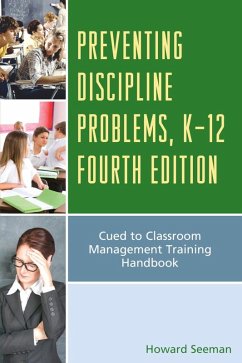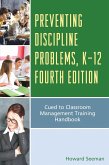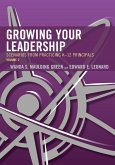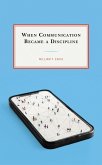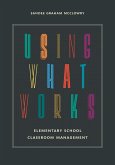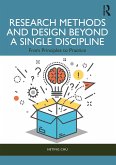Howard Seeman
Preventing Discipline Problems, K-12 (eBook, ePUB)
Cued to Classroom Management Training Handbook
31,95 €
31,95 €
inkl. MwSt.
Sofort per Download lieferbar

16 °P sammeln
31,95 €
Als Download kaufen

31,95 €
inkl. MwSt.
Sofort per Download lieferbar

16 °P sammeln
Jetzt verschenken
Alle Infos zum eBook verschenken
31,95 €
inkl. MwSt.
Sofort per Download lieferbar
Alle Infos zum eBook verschenken

16 °P sammeln
Howard Seeman
Preventing Discipline Problems, K-12 (eBook, ePUB)
Cued to Classroom Management Training Handbook
- Format: ePub
- Merkliste
- Auf die Merkliste
- Bewerten Bewerten
- Teilen
- Produkt teilen
- Produkterinnerung
- Produkterinnerung

Bitte loggen Sie sich zunächst in Ihr Kundenkonto ein oder registrieren Sie sich bei
bücher.de, um das eBook-Abo tolino select nutzen zu können.
Hier können Sie sich einloggen
Hier können Sie sich einloggen
Sie sind bereits eingeloggt. Klicken Sie auf 2. tolino select Abo, um fortzufahren.

Bitte loggen Sie sich zunächst in Ihr Kundenkonto ein oder registrieren Sie sich bei bücher.de, um das eBook-Abo tolino select nutzen zu können.
Preventing Discipline Problems, K-12: Cued to Classroom Management Training Handbook covers every aspect of classroom management and illustrates how to tap into the teacher's most influential tool in the classroom: the person inside the teacher. Schools across the United States, as well as 15 other countries, use this text and accompanying training handbook to help train teachers to negotiate classroom problems. This book helps real teachers deal more effectively with administration, parents, substitute or cluster teaching, bullying, creating a safe classroom environment, and with students who…mehr
- Geräte: eReader
- mit Kopierschutz
- eBook Hilfe
- Größe: 2.29MB
Andere Kunden interessierten sich auch für
![Discipline without Anger (eBook, ePUB) Discipline without Anger (eBook, ePUB)]() Doug CampbellDiscipline without Anger (eBook, ePUB)25,95 €
Doug CampbellDiscipline without Anger (eBook, ePUB)25,95 €![Preventing Discipline Problems, K-12 (eBook, PDF) Preventing Discipline Problems, K-12 (eBook, PDF)]() Howard SeemanPreventing Discipline Problems, K-12 (eBook, PDF)31,95 €
Howard SeemanPreventing Discipline Problems, K-12 (eBook, PDF)31,95 €![Growing Your Leadership: Scenarios from Practicing K-12 Principals (eBook, ePUB) Growing Your Leadership: Scenarios from Practicing K-12 Principals (eBook, ePUB)]() Wanda S. Maulding GreenGrowing Your Leadership: Scenarios from Practicing K-12 Principals (eBook, ePUB)16,95 €
Wanda S. Maulding GreenGrowing Your Leadership: Scenarios from Practicing K-12 Principals (eBook, ePUB)16,95 €![When Communication Became a Discipline (eBook, ePUB) When Communication Became a Discipline (eBook, ePUB)]() William F. EadieWhen Communication Became a Discipline (eBook, ePUB)25,95 €
William F. EadieWhen Communication Became a Discipline (eBook, ePUB)25,95 €![Teaching Mathematics through Problem-Solving in K-12 Classrooms (eBook, ePUB) Teaching Mathematics through Problem-Solving in K-12 Classrooms (eBook, ePUB)]() Matthew OldridgeTeaching Mathematics through Problem-Solving in K-12 Classrooms (eBook, ePUB)21,95 €
Matthew OldridgeTeaching Mathematics through Problem-Solving in K-12 Classrooms (eBook, ePUB)21,95 €![Using What Works (eBook, ePUB) Using What Works (eBook, ePUB)]() Sandee Graham McClowryUsing What Works (eBook, ePUB)21,95 €
Sandee Graham McClowryUsing What Works (eBook, ePUB)21,95 €![Research Methods and Design Beyond a Single Discipline (eBook, ePUB) Research Methods and Design Beyond a Single Discipline (eBook, ePUB)]() Heting ChuResearch Methods and Design Beyond a Single Discipline (eBook, ePUB)58,95 €
Heting ChuResearch Methods and Design Beyond a Single Discipline (eBook, ePUB)58,95 €-
-
-
Preventing Discipline Problems, K-12: Cued to Classroom Management Training Handbook covers every aspect of classroom management and illustrates how to tap into the teacher's most influential tool in the classroom: the person inside the teacher. Schools across the United States, as well as 15 other countries, use this text and accompanying training handbook to help train teachers to negotiate classroom problems. This book helps real teachers deal more effectively with administration, parents, substitute or cluster teaching, bullying, creating a safe classroom environment, and with students who demonstrate a variety of behavioral problems. The author, Howard Seeman, demonstrates how to handle and prevent these various situations. Included in each chapter are self-training, hands-on practice exercises and helpful guidelines and checklists to assist the beginning or veteran teacher. Online course and a live-action training DVD are available. Please contact Howard Seeman at hokaja@aol.com.
Produktdetails
- Produktdetails
- Verlag: Bloomsbury eBooks US
- Seitenzahl: 498
- Erscheinungstermin: 14. August 2014
- Englisch
- ISBN-13: 9781610483865
- Artikelnr.: 41503169
- Verlag: Bloomsbury eBooks US
- Seitenzahl: 498
- Erscheinungstermin: 14. August 2014
- Englisch
- ISBN-13: 9781610483865
- Artikelnr.: 41503169
- Herstellerkennzeichnung Die Herstellerinformationen sind derzeit nicht verfügbar.
Howard Seeman has thirty years of experience teaching in colleges, published over two dozen professional articles, and trained teachers in classroom management.
Preface to the Fourth Edition
Preface to the Third Edition
Preface to the Second Edition
Preface to the First Edition
PART I
Understanding the Problem and the Proper Approach
Chapter 1: Using This Book as a Handbook
A. For Education Majors and Student Teachers
B. For New Teachers or Veteran Teachers Experiencing Difficulties on the
Job
C. For Substitute Teachers
D. For Teachers K-6
E. For Paraprofessionals, Aides
F. For Instructors and Consultants of In-service or Graduate Workshops or
Courses
G. For School Psychologists and Guidance Counselors
H. For Administrators
I. For Supervisors of Student Teachers
J. For Instructors of Education Courses
K. For Parents
Chapter 2: Why Many Attempts Have Been Inadequate
A. What We Need to Do and Be Careful About
B. A Summary and Critique of the Literature
Chapter 3: You're Not Alone: "Right in the Middle of My Lesson, This Kid
Suddenly ..."
Chapter 4: When Should You Call It: "A Discipline Problem"?
A. Not All Disruptions Are "Discipline Problems"
B. Fifteen Typical Miscalls
C. What to Do Instead of Making Miscalls D. Especially for Grades K-6
Chapter 5: From the Horse's Mouth: "I Like to Bug Mr. Johnson Because He
Always ..."
A. From Outside Your Classroom
B. From the Environment of Your Classroom
C. From the Interactions Between You and Your Students
D. From the Delivery of Your Lesson Plan
PART II
Prevention: Locating the Sources of Disruptive Behavior
Chapter 6: From Outside Your Classroom
A. From Childhood to Adolescence
B. From Home and Peers
C. From Right Outside Your Classroom
D. Especially for Grades K-6
Chapter 7: From the Environment of Your Classroom
A. Disorder Breeds Disorder
B. From the Physical Environment
C. From the Seating Arrangement
D. From Your Procedures
E. From Being Poorly Equipped
F. Especially for Grades K-6
Chapter 8: From the Interactions Between You and Your Students
A. From Making Miscalls
B. From Being Incongruent (Inauthentic)
C. From Not Following Through
D. From Being Inappropriate
E. From Being Unfair
F. Especially for Grades K-6
Chapter 9: From the Delivery of Your Lesson Plan
A. From Incongruent Content
B. From Not Being Affective Enough
C. From Not Being Actional or Experiential Enough
D. From Not Being Inductive Enough
E. From Not Being Interactive Enough
F. From a Lack of a Felt Sense of Order, Rewards, and Momentum
G. From a Mismanaged Distribution of Attention
H. From Not Being Supportive or Explained Well Enough
I. Especially for Grades K-6 J. From Poor or Misuse of Technology in the
Classroom
PART III
Preventing and Handling the Sources of Disruptive Behavior
Introduction to Part III: Four Guiding Caveats
Chapter 10: Dealing with Those That Are Somewhat Out of Your Hands
A. Strategies for Handling School Violence
B. Learning How to "Duck"
C. Dealing with Disturbances Right Outside Your Classroom
D. Working on the Environment and Procedures of Your Classroom
a. The physical setting
b. The seating arrangement
c. Your procedures
d. Being Well Equipped: Survival Tools
E. Especially for Grades K-6
a. The physical setting
b. The seating arrangement
c. Your procedures
d. Being Well Equipped: Survival Tools
Chapter 11: Repairing Your Student-Teacher Interactions
A. Not Making Miscalls
B. Being Congruent (Authentic)
C. Following Through
D. Being Appropriate
E. Being Fair
F. Especially for Grades K-6
Chapter 12: Preventing Your Rules from Falling Apart and Growing Healthy
Students
A. 35 Helpful Guidelines for Effective Rules and Warnings
B. The Debates about: "What's Most Effective?"
1. Warnings and Punishments
2. Using Police in Schools
3. Corporal Punishment
4. Extrinsic Rewards
5. Inappropriate Rewards and Punishments
6. Students Design the Rules
7. Suspensions
C. Systematic Rewards, Instead of Punishments: 52 Suggestions.
D. Character Education and Conflict Resolution (CR) Training
E. Strengthening Students to Be Less Vulnerable to Peer Pressure
F. Warding off Bullying:
1. Defining Bullying
2. Strengthening the Victim
a. Parents can
b. Teachers can
1. Re-Forming the Bully
a. Parents can
b. Teachers can
1. 41 Anti-bullying School Strategies
2. 8 School Bullying Prevention Programs; Effective?
3. Laws on Bullying and Cyber Bullying
4. 24 Resources
G. Working on Asserting Yourself and Taking Stands H. Especially for Grades
K-6:
1. What to do the First Day
2. Rules and their Consequences
3. 18 Suggestions for Using "Time-out"
4. Well-Structured Systems of Rewards
5. Encourage Independence
6. Regarding Bullying
Chapter 13: Specifics.
A. How to Handle the: "See Me after Class!"
B. How to Handle Students Who
1. Call out
2. Fight
3. Cheat and/or Plagiarize
4. Come in late
5. Don't do the homework
6. Have crushes on you
7. Wear hats
8. Bring personal stereos, iPods, to class
9. Have Cell Phones and do Texting
10. Criticize, "dis," each other
11. Are "high" or dealing drugs
12. Carry weapons:
a. Extent of the Problem
b. Kinds of "Weapons"
c. What a School Can Do
i. 34 Helpful Security Strategies
ii. A Sample Policy Statement
d. What a Teacher Should Do
e. Resources
C. Especially for Grades K-6
Chapter 14: Repairing the Delivery of Your Lesson Plan: 113 Engagement
Methods
A. Delivering the Subject Matter Congruently
B. Making the Lesson Affective
C. Making the Lesson Actional and Experiential
D. Making the Lesson More Inductive
E. Involving the Students: Participation Methods
F. Creating Lessons That Feel Orderly and Have Rewards and Momentum
G. Managing the Distribution of Attention
H. Making the Lesson Supportive and Explained Well
I. Especially for Grades K-6
J. Using Technology in the Classroom
Chapter 15: The Substitute Teacher
A. Securing the Subbing Job
B. Some Helpful Techniques for Effective Subbing
C. Some Useful Do-Nows, Bellwork, Task Sheets
D. Especially for Grades K-6
Chapter 16: Epilogue: "Teachers: You Matter!"
Bibliography
Index
About the Author
Preface to the Third Edition
Preface to the Second Edition
Preface to the First Edition
PART I
Understanding the Problem and the Proper Approach
Chapter 1: Using This Book as a Handbook
A. For Education Majors and Student Teachers
B. For New Teachers or Veteran Teachers Experiencing Difficulties on the
Job
C. For Substitute Teachers
D. For Teachers K-6
E. For Paraprofessionals, Aides
F. For Instructors and Consultants of In-service or Graduate Workshops or
Courses
G. For School Psychologists and Guidance Counselors
H. For Administrators
I. For Supervisors of Student Teachers
J. For Instructors of Education Courses
K. For Parents
Chapter 2: Why Many Attempts Have Been Inadequate
A. What We Need to Do and Be Careful About
B. A Summary and Critique of the Literature
Chapter 3: You're Not Alone: "Right in the Middle of My Lesson, This Kid
Suddenly ..."
Chapter 4: When Should You Call It: "A Discipline Problem"?
A. Not All Disruptions Are "Discipline Problems"
B. Fifteen Typical Miscalls
C. What to Do Instead of Making Miscalls D. Especially for Grades K-6
Chapter 5: From the Horse's Mouth: "I Like to Bug Mr. Johnson Because He
Always ..."
A. From Outside Your Classroom
B. From the Environment of Your Classroom
C. From the Interactions Between You and Your Students
D. From the Delivery of Your Lesson Plan
PART II
Prevention: Locating the Sources of Disruptive Behavior
Chapter 6: From Outside Your Classroom
A. From Childhood to Adolescence
B. From Home and Peers
C. From Right Outside Your Classroom
D. Especially for Grades K-6
Chapter 7: From the Environment of Your Classroom
A. Disorder Breeds Disorder
B. From the Physical Environment
C. From the Seating Arrangement
D. From Your Procedures
E. From Being Poorly Equipped
F. Especially for Grades K-6
Chapter 8: From the Interactions Between You and Your Students
A. From Making Miscalls
B. From Being Incongruent (Inauthentic)
C. From Not Following Through
D. From Being Inappropriate
E. From Being Unfair
F. Especially for Grades K-6
Chapter 9: From the Delivery of Your Lesson Plan
A. From Incongruent Content
B. From Not Being Affective Enough
C. From Not Being Actional or Experiential Enough
D. From Not Being Inductive Enough
E. From Not Being Interactive Enough
F. From a Lack of a Felt Sense of Order, Rewards, and Momentum
G. From a Mismanaged Distribution of Attention
H. From Not Being Supportive or Explained Well Enough
I. Especially for Grades K-6 J. From Poor or Misuse of Technology in the
Classroom
PART III
Preventing and Handling the Sources of Disruptive Behavior
Introduction to Part III: Four Guiding Caveats
Chapter 10: Dealing with Those That Are Somewhat Out of Your Hands
A. Strategies for Handling School Violence
B. Learning How to "Duck"
C. Dealing with Disturbances Right Outside Your Classroom
D. Working on the Environment and Procedures of Your Classroom
a. The physical setting
b. The seating arrangement
c. Your procedures
d. Being Well Equipped: Survival Tools
E. Especially for Grades K-6
a. The physical setting
b. The seating arrangement
c. Your procedures
d. Being Well Equipped: Survival Tools
Chapter 11: Repairing Your Student-Teacher Interactions
A. Not Making Miscalls
B. Being Congruent (Authentic)
C. Following Through
D. Being Appropriate
E. Being Fair
F. Especially for Grades K-6
Chapter 12: Preventing Your Rules from Falling Apart and Growing Healthy
Students
A. 35 Helpful Guidelines for Effective Rules and Warnings
B. The Debates about: "What's Most Effective?"
1. Warnings and Punishments
2. Using Police in Schools
3. Corporal Punishment
4. Extrinsic Rewards
5. Inappropriate Rewards and Punishments
6. Students Design the Rules
7. Suspensions
C. Systematic Rewards, Instead of Punishments: 52 Suggestions.
D. Character Education and Conflict Resolution (CR) Training
E. Strengthening Students to Be Less Vulnerable to Peer Pressure
F. Warding off Bullying:
1. Defining Bullying
2. Strengthening the Victim
a. Parents can
b. Teachers can
1. Re-Forming the Bully
a. Parents can
b. Teachers can
1. 41 Anti-bullying School Strategies
2. 8 School Bullying Prevention Programs; Effective?
3. Laws on Bullying and Cyber Bullying
4. 24 Resources
G. Working on Asserting Yourself and Taking Stands H. Especially for Grades
K-6:
1. What to do the First Day
2. Rules and their Consequences
3. 18 Suggestions for Using "Time-out"
4. Well-Structured Systems of Rewards
5. Encourage Independence
6. Regarding Bullying
Chapter 13: Specifics.
A. How to Handle the: "See Me after Class!"
B. How to Handle Students Who
1. Call out
2. Fight
3. Cheat and/or Plagiarize
4. Come in late
5. Don't do the homework
6. Have crushes on you
7. Wear hats
8. Bring personal stereos, iPods, to class
9. Have Cell Phones and do Texting
10. Criticize, "dis," each other
11. Are "high" or dealing drugs
12. Carry weapons:
a. Extent of the Problem
b. Kinds of "Weapons"
c. What a School Can Do
i. 34 Helpful Security Strategies
ii. A Sample Policy Statement
d. What a Teacher Should Do
e. Resources
C. Especially for Grades K-6
Chapter 14: Repairing the Delivery of Your Lesson Plan: 113 Engagement
Methods
A. Delivering the Subject Matter Congruently
B. Making the Lesson Affective
C. Making the Lesson Actional and Experiential
D. Making the Lesson More Inductive
E. Involving the Students: Participation Methods
F. Creating Lessons That Feel Orderly and Have Rewards and Momentum
G. Managing the Distribution of Attention
H. Making the Lesson Supportive and Explained Well
I. Especially for Grades K-6
J. Using Technology in the Classroom
Chapter 15: The Substitute Teacher
A. Securing the Subbing Job
B. Some Helpful Techniques for Effective Subbing
C. Some Useful Do-Nows, Bellwork, Task Sheets
D. Especially for Grades K-6
Chapter 16: Epilogue: "Teachers: You Matter!"
Bibliography
Index
About the Author
Preface to the Fourth Edition
Preface to the Third Edition
Preface to the Second Edition
Preface to the First Edition
PART I
Understanding the Problem and the Proper Approach
Chapter 1: Using This Book as a Handbook
A. For Education Majors and Student Teachers
B. For New Teachers or Veteran Teachers Experiencing Difficulties on the
Job
C. For Substitute Teachers
D. For Teachers K-6
E. For Paraprofessionals, Aides
F. For Instructors and Consultants of In-service or Graduate Workshops or
Courses
G. For School Psychologists and Guidance Counselors
H. For Administrators
I. For Supervisors of Student Teachers
J. For Instructors of Education Courses
K. For Parents
Chapter 2: Why Many Attempts Have Been Inadequate
A. What We Need to Do and Be Careful About
B. A Summary and Critique of the Literature
Chapter 3: You're Not Alone: "Right in the Middle of My Lesson, This Kid
Suddenly ..."
Chapter 4: When Should You Call It: "A Discipline Problem"?
A. Not All Disruptions Are "Discipline Problems"
B. Fifteen Typical Miscalls
C. What to Do Instead of Making Miscalls D. Especially for Grades K-6
Chapter 5: From the Horse's Mouth: "I Like to Bug Mr. Johnson Because He
Always ..."
A. From Outside Your Classroom
B. From the Environment of Your Classroom
C. From the Interactions Between You and Your Students
D. From the Delivery of Your Lesson Plan
PART II
Prevention: Locating the Sources of Disruptive Behavior
Chapter 6: From Outside Your Classroom
A. From Childhood to Adolescence
B. From Home and Peers
C. From Right Outside Your Classroom
D. Especially for Grades K-6
Chapter 7: From the Environment of Your Classroom
A. Disorder Breeds Disorder
B. From the Physical Environment
C. From the Seating Arrangement
D. From Your Procedures
E. From Being Poorly Equipped
F. Especially for Grades K-6
Chapter 8: From the Interactions Between You and Your Students
A. From Making Miscalls
B. From Being Incongruent (Inauthentic)
C. From Not Following Through
D. From Being Inappropriate
E. From Being Unfair
F. Especially for Grades K-6
Chapter 9: From the Delivery of Your Lesson Plan
A. From Incongruent Content
B. From Not Being Affective Enough
C. From Not Being Actional or Experiential Enough
D. From Not Being Inductive Enough
E. From Not Being Interactive Enough
F. From a Lack of a Felt Sense of Order, Rewards, and Momentum
G. From a Mismanaged Distribution of Attention
H. From Not Being Supportive or Explained Well Enough
I. Especially for Grades K-6 J. From Poor or Misuse of Technology in the
Classroom
PART III
Preventing and Handling the Sources of Disruptive Behavior
Introduction to Part III: Four Guiding Caveats
Chapter 10: Dealing with Those That Are Somewhat Out of Your Hands
A. Strategies for Handling School Violence
B. Learning How to "Duck"
C. Dealing with Disturbances Right Outside Your Classroom
D. Working on the Environment and Procedures of Your Classroom
a. The physical setting
b. The seating arrangement
c. Your procedures
d. Being Well Equipped: Survival Tools
E. Especially for Grades K-6
a. The physical setting
b. The seating arrangement
c. Your procedures
d. Being Well Equipped: Survival Tools
Chapter 11: Repairing Your Student-Teacher Interactions
A. Not Making Miscalls
B. Being Congruent (Authentic)
C. Following Through
D. Being Appropriate
E. Being Fair
F. Especially for Grades K-6
Chapter 12: Preventing Your Rules from Falling Apart and Growing Healthy
Students
A. 35 Helpful Guidelines for Effective Rules and Warnings
B. The Debates about: "What's Most Effective?"
1. Warnings and Punishments
2. Using Police in Schools
3. Corporal Punishment
4. Extrinsic Rewards
5. Inappropriate Rewards and Punishments
6. Students Design the Rules
7. Suspensions
C. Systematic Rewards, Instead of Punishments: 52 Suggestions.
D. Character Education and Conflict Resolution (CR) Training
E. Strengthening Students to Be Less Vulnerable to Peer Pressure
F. Warding off Bullying:
1. Defining Bullying
2. Strengthening the Victim
a. Parents can
b. Teachers can
1. Re-Forming the Bully
a. Parents can
b. Teachers can
1. 41 Anti-bullying School Strategies
2. 8 School Bullying Prevention Programs; Effective?
3. Laws on Bullying and Cyber Bullying
4. 24 Resources
G. Working on Asserting Yourself and Taking Stands H. Especially for Grades
K-6:
1. What to do the First Day
2. Rules and their Consequences
3. 18 Suggestions for Using "Time-out"
4. Well-Structured Systems of Rewards
5. Encourage Independence
6. Regarding Bullying
Chapter 13: Specifics.
A. How to Handle the: "See Me after Class!"
B. How to Handle Students Who
1. Call out
2. Fight
3. Cheat and/or Plagiarize
4. Come in late
5. Don't do the homework
6. Have crushes on you
7. Wear hats
8. Bring personal stereos, iPods, to class
9. Have Cell Phones and do Texting
10. Criticize, "dis," each other
11. Are "high" or dealing drugs
12. Carry weapons:
a. Extent of the Problem
b. Kinds of "Weapons"
c. What a School Can Do
i. 34 Helpful Security Strategies
ii. A Sample Policy Statement
d. What a Teacher Should Do
e. Resources
C. Especially for Grades K-6
Chapter 14: Repairing the Delivery of Your Lesson Plan: 113 Engagement
Methods
A. Delivering the Subject Matter Congruently
B. Making the Lesson Affective
C. Making the Lesson Actional and Experiential
D. Making the Lesson More Inductive
E. Involving the Students: Participation Methods
F. Creating Lessons That Feel Orderly and Have Rewards and Momentum
G. Managing the Distribution of Attention
H. Making the Lesson Supportive and Explained Well
I. Especially for Grades K-6
J. Using Technology in the Classroom
Chapter 15: The Substitute Teacher
A. Securing the Subbing Job
B. Some Helpful Techniques for Effective Subbing
C. Some Useful Do-Nows, Bellwork, Task Sheets
D. Especially for Grades K-6
Chapter 16: Epilogue: "Teachers: You Matter!"
Bibliography
Index
About the Author
Preface to the Third Edition
Preface to the Second Edition
Preface to the First Edition
PART I
Understanding the Problem and the Proper Approach
Chapter 1: Using This Book as a Handbook
A. For Education Majors and Student Teachers
B. For New Teachers or Veteran Teachers Experiencing Difficulties on the
Job
C. For Substitute Teachers
D. For Teachers K-6
E. For Paraprofessionals, Aides
F. For Instructors and Consultants of In-service or Graduate Workshops or
Courses
G. For School Psychologists and Guidance Counselors
H. For Administrators
I. For Supervisors of Student Teachers
J. For Instructors of Education Courses
K. For Parents
Chapter 2: Why Many Attempts Have Been Inadequate
A. What We Need to Do and Be Careful About
B. A Summary and Critique of the Literature
Chapter 3: You're Not Alone: "Right in the Middle of My Lesson, This Kid
Suddenly ..."
Chapter 4: When Should You Call It: "A Discipline Problem"?
A. Not All Disruptions Are "Discipline Problems"
B. Fifteen Typical Miscalls
C. What to Do Instead of Making Miscalls D. Especially for Grades K-6
Chapter 5: From the Horse's Mouth: "I Like to Bug Mr. Johnson Because He
Always ..."
A. From Outside Your Classroom
B. From the Environment of Your Classroom
C. From the Interactions Between You and Your Students
D. From the Delivery of Your Lesson Plan
PART II
Prevention: Locating the Sources of Disruptive Behavior
Chapter 6: From Outside Your Classroom
A. From Childhood to Adolescence
B. From Home and Peers
C. From Right Outside Your Classroom
D. Especially for Grades K-6
Chapter 7: From the Environment of Your Classroom
A. Disorder Breeds Disorder
B. From the Physical Environment
C. From the Seating Arrangement
D. From Your Procedures
E. From Being Poorly Equipped
F. Especially for Grades K-6
Chapter 8: From the Interactions Between You and Your Students
A. From Making Miscalls
B. From Being Incongruent (Inauthentic)
C. From Not Following Through
D. From Being Inappropriate
E. From Being Unfair
F. Especially for Grades K-6
Chapter 9: From the Delivery of Your Lesson Plan
A. From Incongruent Content
B. From Not Being Affective Enough
C. From Not Being Actional or Experiential Enough
D. From Not Being Inductive Enough
E. From Not Being Interactive Enough
F. From a Lack of a Felt Sense of Order, Rewards, and Momentum
G. From a Mismanaged Distribution of Attention
H. From Not Being Supportive or Explained Well Enough
I. Especially for Grades K-6 J. From Poor or Misuse of Technology in the
Classroom
PART III
Preventing and Handling the Sources of Disruptive Behavior
Introduction to Part III: Four Guiding Caveats
Chapter 10: Dealing with Those That Are Somewhat Out of Your Hands
A. Strategies for Handling School Violence
B. Learning How to "Duck"
C. Dealing with Disturbances Right Outside Your Classroom
D. Working on the Environment and Procedures of Your Classroom
a. The physical setting
b. The seating arrangement
c. Your procedures
d. Being Well Equipped: Survival Tools
E. Especially for Grades K-6
a. The physical setting
b. The seating arrangement
c. Your procedures
d. Being Well Equipped: Survival Tools
Chapter 11: Repairing Your Student-Teacher Interactions
A. Not Making Miscalls
B. Being Congruent (Authentic)
C. Following Through
D. Being Appropriate
E. Being Fair
F. Especially for Grades K-6
Chapter 12: Preventing Your Rules from Falling Apart and Growing Healthy
Students
A. 35 Helpful Guidelines for Effective Rules and Warnings
B. The Debates about: "What's Most Effective?"
1. Warnings and Punishments
2. Using Police in Schools
3. Corporal Punishment
4. Extrinsic Rewards
5. Inappropriate Rewards and Punishments
6. Students Design the Rules
7. Suspensions
C. Systematic Rewards, Instead of Punishments: 52 Suggestions.
D. Character Education and Conflict Resolution (CR) Training
E. Strengthening Students to Be Less Vulnerable to Peer Pressure
F. Warding off Bullying:
1. Defining Bullying
2. Strengthening the Victim
a. Parents can
b. Teachers can
1. Re-Forming the Bully
a. Parents can
b. Teachers can
1. 41 Anti-bullying School Strategies
2. 8 School Bullying Prevention Programs; Effective?
3. Laws on Bullying and Cyber Bullying
4. 24 Resources
G. Working on Asserting Yourself and Taking Stands H. Especially for Grades
K-6:
1. What to do the First Day
2. Rules and their Consequences
3. 18 Suggestions for Using "Time-out"
4. Well-Structured Systems of Rewards
5. Encourage Independence
6. Regarding Bullying
Chapter 13: Specifics.
A. How to Handle the: "See Me after Class!"
B. How to Handle Students Who
1. Call out
2. Fight
3. Cheat and/or Plagiarize
4. Come in late
5. Don't do the homework
6. Have crushes on you
7. Wear hats
8. Bring personal stereos, iPods, to class
9. Have Cell Phones and do Texting
10. Criticize, "dis," each other
11. Are "high" or dealing drugs
12. Carry weapons:
a. Extent of the Problem
b. Kinds of "Weapons"
c. What a School Can Do
i. 34 Helpful Security Strategies
ii. A Sample Policy Statement
d. What a Teacher Should Do
e. Resources
C. Especially for Grades K-6
Chapter 14: Repairing the Delivery of Your Lesson Plan: 113 Engagement
Methods
A. Delivering the Subject Matter Congruently
B. Making the Lesson Affective
C. Making the Lesson Actional and Experiential
D. Making the Lesson More Inductive
E. Involving the Students: Participation Methods
F. Creating Lessons That Feel Orderly and Have Rewards and Momentum
G. Managing the Distribution of Attention
H. Making the Lesson Supportive and Explained Well
I. Especially for Grades K-6
J. Using Technology in the Classroom
Chapter 15: The Substitute Teacher
A. Securing the Subbing Job
B. Some Helpful Techniques for Effective Subbing
C. Some Useful Do-Nows, Bellwork, Task Sheets
D. Especially for Grades K-6
Chapter 16: Epilogue: "Teachers: You Matter!"
Bibliography
Index
About the Author
